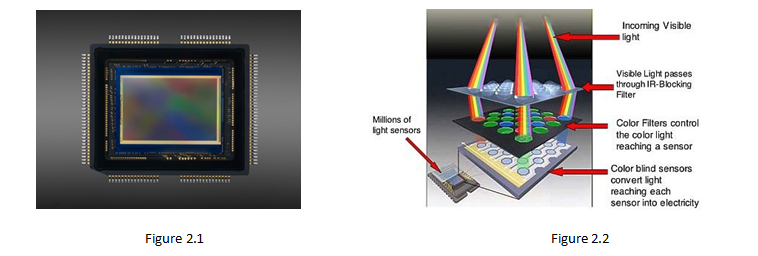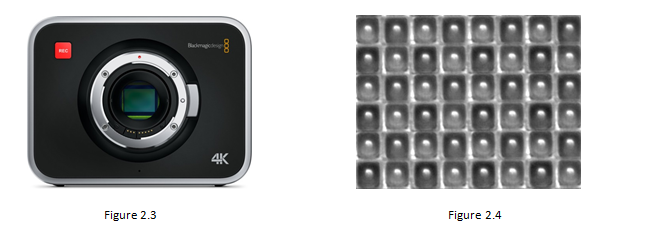In this study, the image resolution of the human eye and of a professional cinema camera have been examined and compared based on the surface area and density of the light receptors in both the human retina and in the CMOS digital imaging sensor. Based upon our comparisons, the conclusion that was drawn reveals that the image the human eye perceives has a higher resolution than that of current technology of state-of-the-art professional cinema cameras.
Human Retina
The sensor or light-sensing structure of the eye is called the retina. Before light can reach the retina it must first pass through the cornea, then the aqueous humor, lens and vitreous humor (Figure 1.1).

The retina contains two types of light receptor cells, called rods and cones (Figures 1.2 and 1.3). Rods handle vision in low light, usually at night or in a dark room, and cones handle color vision and detail. The rods and cones of the human eye in total are numbered at a total of 63,296,000 –consisting of 60,123,000 rodsand 3,173,000 cones in an area of 1204 mm2. The density of retinal photoreceptors in the human retinal is around 52,571.4/mm2. (Figure 1.4

Professional Cinema Camera’s CMOS Sensor
The digital sensor of a digital camera (Figure 2.1) accomplishes capturing light and converting it into electrical signals.
A CMOS imaging chip is a type of active pixel sensor made using the CMOS semiconductor process. Extra circuitry next to each photo sensor converts the light energy to a voltage. Additional circuitry on the chip may be included to convert the voltage to digital data (Figure 2.2) [4].

In the technical specifications of the professional cinema camera produced by Blackmagic Design (Production Camera 4K) (Figure 2.3), we find that the active resolution of less than half a square-inch CMOS digital image sensor is 3840 x 2160 (4K – UHD), which totals 8,294,400 light receptors. The light sensor density of the Blackmagic Production Camera 4K is around 33,057.8/mm2.

Conclusion
The human retina has a total of about 63 million light sensors in an area of 1204 mm2. That means that the total light sensor density of the human eye is around 52,571.4/mm2. The total light sensor density of the CMOS sensor of the Blackmagic Production Camera 4K is just over 33,057.8/mm2. That means the human retina has around 1.6 times more light sensors per square millimeter than the cinema camera’s CMOS sensor.
What does this mean for the human retina? Having smaller light sensors means they need more light to function. This is why humans can’t see that well in the dark.
According to our calculations, the human eye perceives around 1.6 times higher resolution images (but has 1.6 times less function in low light) than a professional state-of-the-art cinema camera.
Bibliography/Sources
[1] Ophthalmology. 1994 Mar;101(3):519-23. Retinal photoreceptor count, retinal surface area, and optic disc size in normal human eyes. Panda-Jonas S, Jonas JB, Jakobczyk M, Schneider U.
[2] Blackmagic Design, Blackmagic Production Camera 4K, Tech Specs: Effective Sensor Size, Effective Resolution.http://www.blackmagicdesign.com/products/blackmagicproductioncamera4k/techspecs
Images:
[3] Figure 1.1: http://bionicvision.org.au/__data/assets/image/0003/464151/Eye_Anatomy.jpg
[4] Figure 1.2: http://conxcorp.com/images/content/image10.jpeg
[5] Figure 1.3: http://ncifrederick.cancer.gov/atp/cms/wp-content/uploads/2010/11/retina3.gif
[6] Figure 2.1: http://imaging.nikon.com/lineup/coolpix/a/a/img/features02/img_01.png
[7] Figure 2.2: http://mydigitalcamera.us/wp-content/uploads/2010/10/digital_camera_sensor1.jpg
[8] Figure 2.3: http://www.blackmagicdesign.com/media/5279527/sensor.jpg
[9] Figure 2.4: http://petapixel.com/assets/uploads/2013/02/cmosmicrograph-3.jpg
Isaac Katekkou is currently a volunteer from B’ Technical School (Nicosia) in Mediazone doing a work placement – and has been with us as a volunteer for Graduation since 2011

